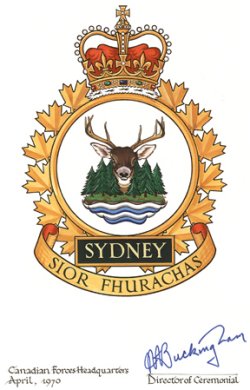NOTICE:Some photos and documents may be marked with varying degrees of classification, up to SECRET. Data so marked is the way it was delivered from official USAF sources, and have been completely declassified. To the best of our knowledge, no currently classified data is stored on this site.The following site information is available: History of Sydney AS, NS, CNOn 15 March 1953, the second RCAF Station Sydney, this one located on the northern fringes overlooking the city, was activated. April 1953 saw the advance party arrive at a new radar site at Sydney, Nova Scotia (C-34). The unit was officially formed as 221 Aircraft Warning Squadron (callsign Pepper), Sydney on 1 August 1953 and was to perform Early Warning and Ground Control Intercept duties. 221Squadron reported to No. 2 ADCC Chatham. The GCI radar unit, 211 Radar Squadron, became operational for manual operations on a 24-hour basis in April 1954 and in 1962 began to convert to the SAGE system. RCAF Station Sydney was also the home of the Royal Cape Breton Air Force which had been formed on 25 April 1956 during an Officer's Mess Dinner. The RCBAF commemorates the fact that the first powered flight in the British Commonwealth took place not far away on Baddeck Lake on 23 February 1909. The RCBAF also perpetuated the fact that being rather isolated and having received so few visitors from higher headquarters, they began to do things in their "own way" and paid only "lip service" to TOAF (That Other Air Force). Traditions of the RCBAF included their own mess dress (the inclusion of a Cape Breton tarton bow tie, instead of the black tie), a special rum toast at a mess dinner where every member would climb onto their chairs and place their right foot on the table and reverently say - "Chimo RCBAF" and their own motto "Nil illegitimus Carborum Dum", or translated "Don't let the bastards grind you down". All in all, the RCBAF was great fun and it was considered an honor to become a member. In the autumn of 1958, the station played an important part during the 50th anniversary celebration of powered flight in Canada. It provided support for the replica Silver Dart commemoration flight by Wing Commander Hartman. In June 1961, the Canadian government assumed full financial responsibilities of RCAF Station Sydney from the Americans under the Triangular Agreement.. The station was SAGE-capable on 15 September 1962. Later, the station became known as 211 Radar Squadron until 1967 when it became known as a Canadian Forces Station. CFS Sydney's headquarters was the base of operations for the Canadian Navy in 1986 for the NATO exercise "Sea Supply 86". In the spring of 1983, CFS Sydney became a part of the Canada East ROCC located in North Bay. The Height Finder was shut down on 1 April 1990 as a part of the plan to close the station. Closure of CFS Sydney, the only unit of the RCAF/Canadian Forces to have Gaelic on their crest, was completed in 1993. Today, Sydney is one of three sites on the east coast to have a Canadian Coastal Radar facility. --The NBC Group - Don Nicks, John Bradley, Chris Charland. |
 |